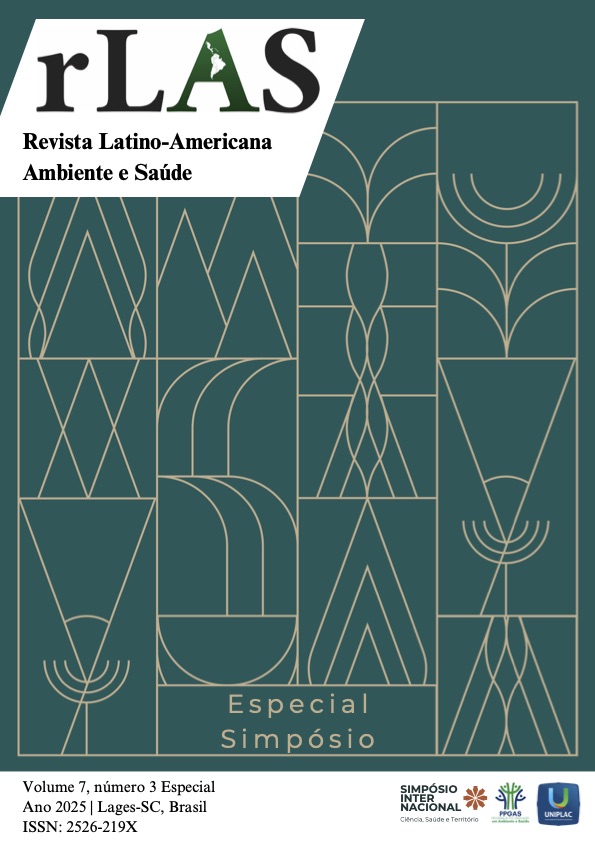Araucaria Forest fragment as a refuge for endemic and threatened sp
Keywords:
Atlantic Forest, invasive exotic, conservationAbstract
The objective of this study was to survey the tree species in a fragment of Montane Mixed Ombrophilous Forest, located in the Mountain Range Plateau of Santa Catarina, in the region of Lages, Santa Catarina (SC), Brazil. Additionally, the study aimed to assess the extinction threat level and endemism of these species. The methodology used was free walking, where species were recorded while the area was traversed. A total of 36 species belonging to 24 families were identified, including two conifers and the remainder Angiosperms. Among the 36 species, two are gymnosperms: one is Critically Endangered (Araucaria angustifolia) and the other is Near Threatened (Podocarpus lambertii). Regarding endemism, the species Jacaranda puberula, Myrceugenia euosma, Podocarpus lambertii and Sebastiania brasiliensis are endemic to Brazil, while Cinnamodendron dinisii and Zanthoxylum kleinii are endemic to both the Atlantic Forest and Brazil. The survey also identified the presence of the invasive exotic species Ligustrum lucidum within the forest fragment. The results reinforce the importance of studies that support the development of strategies for the conservation of the Atlantic Forest and the sustainable use of its natural resources.
References
ANGIOSPERM PHYLOGENY GROUP (2009). An update of the Angiosperm Phylogeny Group classification for the orders and families of flowering plants: APG III. Botanical Journal of the Linnean Society 161: 105-121, abr., 2016.
CARVALHO, P. E. R. Espécies Arbóreas Brasileiras. Brasília: Embrapa, 2003.
FILGUEIRAS, T.S. et al. Caminhamento: Um método expedito para levantamentos florísticos qualitativos. Caderno de Geociência IBGE, p.39-43, dez., 1994.
Flora e Funga do Brasil. Jardim Botânico do Rio de Janeiro. Disponível em: < http://floradobrasil.jbrj.gov.br/ >. Acesso em: 21 abr. 2025.
HUMMEL, R.B. et al. Análise preliminar da invasão biológica por Lingustrum lucidum W.T. Aiton em unidade de conservação no Rio Grande do Sul. Caderno de Pesquisa, série Biologia, n. 3, p. 14-26, 2014.
IBGE. Manual Técnico da Vegetação Brasileira. 2. ed. Rio de Janeiro: IBGE, 2012.
IUCN. 2025. Lista Vermelha de Espécies Ameaçadas da IUCN. Versão 2025.1. Disponível em < https://www.iucnredlist.org > Acesso em: 21 abr. de 2025.
RONDON NETO, R.M. et al. Análise florística e estrutural de um fragmento de Floresta Ombrófila Mista Montana, situado em Criúva, RS – Brasil. Ciência Florestal, Santa Maria, v. 12, n. 1, p.29-37, 2002.
SILVEIRA, E. R.; et al. Situação das famílias na extração e comercialização do pinhão no sudoeste do Paraná. Synergismus Scyentifica, v. 6, p. 1 - 6, 2011.
SOS MATA ATLÂNTICA; INPE. Atlas dos Remanescentes Florestais da Mata Atlântica: Período 2021-2022. São Paulo, 2022. Disponível em: <https://www.sosma.org.br/wp-content/uploads/2023/05/Atlas-da-Mata-Atlantica_2021-2022.pdf>. Acesso em: 25 de abril de 2025.
ORGANIZAÇÃO DAS NAÇÕES UNIDAS. Transformando nosso mundo: a Agenda 2030 para o Desenvolvimento Sustentável. Brasília: ONU Brasil, 2015. Disponível em: <https://brasil.un.org/sites/default/files/2020-09/agenda2030-pt-br.pdf>. Acesso em: 20 mai. 2025.


